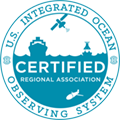Ocean Acidification
Ocean acidification refers to the ongoing change in the chemistry of the ocean caused primarily by the ocean's absorption of carbon dioxide from the atmosphere. For the last 250 years, the burning of fossil fuels — coal, oil, natural gas — for energy, cement production, and deforestation has been pumping carbon dioxide or CO2, into the atmosphere. The ocean absorbs about 1/4 of this excess CO2 released into the atmosphere every year. This addition of CO2 into the ocean is changing the chemistry of seawater by increasing the acidity and lowering the seawater's naturally occurring carbonate ion. CO2, when combined with water, forms a weak acid, which increases the hydrogen ion concentration in the ocean, lowering the pH and making the oceans less alkaline or more acidic. As the ocean becomes less alkaline there is a reduction in the amount of carbonate ions and calcium carbonate minerals, biologically important building blocks for many marine organisms.

PMEL/NOAA
This graph shows the correlation between rising levels of carbon dioxide (CO2) in the atmosphere at Mauna Loa, Hawaii, with rising CO2 levels in the nearby ocean at Station Aloha. As more CO2 accumulates in the ocean, the pH of the ocean decreases. Modified after R.A. Feely, Bulletin of the American Meteorological Society, July 2008
Since 1750, the average acidity of the ocean has increased about 30 percent. The current rate of acidification is nearly 10 times faster than any time in the past 50 million years, outpacing the ocean’s capacity to restore oceanic pH and carbonate chemistry. The rapid pace of change gives marine organisms, marine ecosystems, and humans less time to adapt, evolve, or otherwise adjust to the changing circumstances.
Many life processes, including photosynthesis, growth, respiration, recruitment, reproduction, and behavior are sensitive to carbon dioxide and pH. As a result, ocean acidification has the potential to affect a wide range of organisms, from marine invertebrates like shellfish, to photosynthesizers including phytoplankton and seagrasses, as well as vertebrates including fish in many different ways.

PMEL/NOAA
The absorption of excessive amounts of CO2 from the atmosphere is changing the chemistry of seawater by increasing the acidity and lowering the seawater's naturally occurring carbonate ion, a building block of the calcium carbonate required of many marine organisms to grow their shells and skeletons. Ocean acidification reduces calcification rates in shell-forming organisms such as corals and shellfish. In coastal areas with coral reefs, reef structures impacted by ocean acidification are weaker and less able to protect coastal communities from storm damage. Economically important shellfish species such as oysters, scallops, mussels, and clams are negatively impacted by reduced calcification rates brought on by ocean acidification, particularly in larval stages shell building. Other calcifying organisms like tiny sea snails known as pteropods are affected by the chemistry changes. Shelled pteropods are a critical food source for salmon, mackerel, herring, cod, and even whales.
Additional Resources
20 Facts About Ocean Acidification
Ocean Acidification in the Pacific Northwest: The Facts
This fact sheet summarizes our growing understanding of the causes and consequences of ocean acidification in the Pacific Northwest marine waters.
NOAA Pacific Marine Environmental Lab Carbon Program
NOAA Ocean Acidification Program
NOAA Northwest Fisheries Science Center
Washington State Blue Ribbon Panel on Ocean Acidification
Scientific Summary of Ocean Acidification in Washington State Marine Waters
West Coast Ocean Acidification and Hypoxia Science Panel
California Current Acidification Network (C-CAN)
Ocean Acidification Around the World
An interactive tool designed to make ocean acidification understandable by tracking emerging science and providing updates on what is occurring and where.
Washington Ocean Acidification Center
Ocean Acidification.Net
An informational website to bring information on ocean acidification to scientists, policymakers, and the public. Maintained by the International Geosphere-Biosphere Programme (IGBP).
NANOOS and the Shellfish Industry
A Senior Biologist at the Pacific Shellfish Institute describes how near-real time water quality data is used to inform shellfish growers and minimize larval mortalities.
IOOS Pacific Region Ocean Acidification
Ocean Technology Transition Project
NANOOS and its partners have been awarded a grant to improve OA observing capability along the U.S. west coast.
Related NANOOS Products
NANOOS Visualization System (NVS)
NVS Shellfish Growers App
NVS Data Explorer App
NVS Salish Cruise App
Related Videos
NOAA IOOS Video on Ocean Acidification
Washington Ocean Acidification Center
University of Washington Applied Physics Laboratory Video on the Washington Ocean Acidification Center and NANOOS
Acidity on the Halfshell
A five minute presentation by Libby Jewett of NOAA OAP.
Ocean Acidification in Puget Sound
Produced by students from the Suquamish Tribal Early College High School.
The Other CO2 Problem
Animation video by Ridgeway School students, Plymouth, UK.
Tracking an Ocean of Carbon
Narrated by Dr. Chris Sabine.
Acid Ocean
A short BBC Newsnight film on the impact of CO2 on the Ocean.
| National Observing System Partners Alliance for Coastal Technologies (ACT) Southeastern Universities Research Association (SURA) Integrated Ocean Observing System IOOS | |||||||

